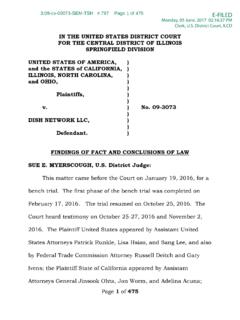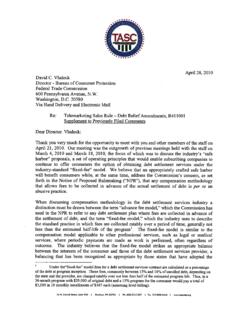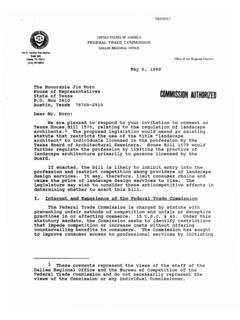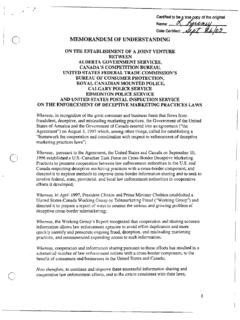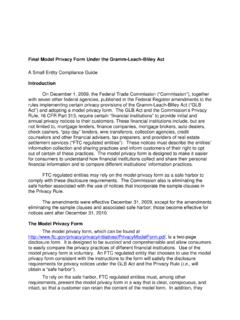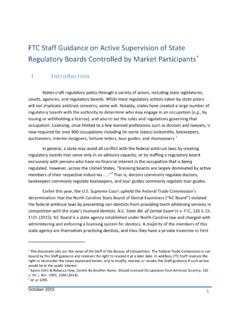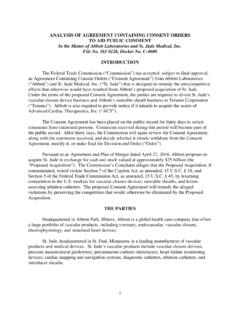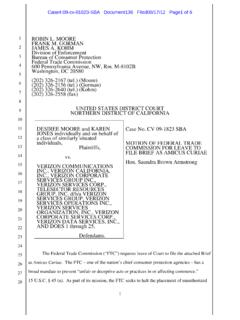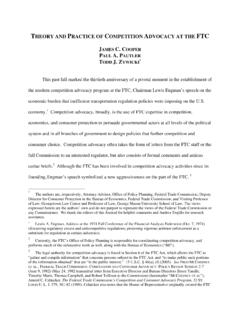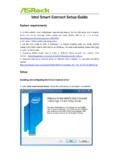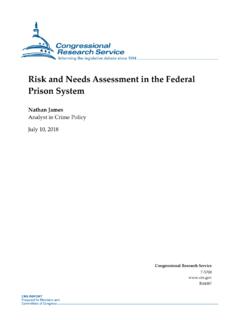Transcription of Advertising to Kids and the FTC: A Regulatory ...
1 1 This article was prepared with the assistance of Carol J. Jennings, Attorney, Division ofEnforcement, and Mary Koelbel Engle, Associate Director for Advertising Practices, FederalTrade Commission. Editorial assistance was provided by C. Lee Peeler, Deputy Director,Bureau of Consumer Protection, Federal Trade Commission. The article is based upon a speechdelivered by J. Howard Beales, III, Director of the Bureau of Consumer Protection, before theGeorge Mason Law Review 2004 Symposium on Antitrust and Consumer Policy Statement, appended to Cliffdale Associates, Inc., 103 110, 176(1984).4Id. at to Kids and the FTC: A Regulatory Retrospective That Advises the Present1 It s deja vu all over again.
2 Yogi BerraI. INTRODUCTIONThe Federal Trade Commission (FTC) has a long history of protecting children fromunfair and deceptive marketing practices. In doing so, the Commission has recognized thespecial nature of the child audience. For example, children may be deceived by an image or amessage that likely would not deceive an adult. Some of the agency s efforts have beensuccessful, while other have not. This article explores the history of these efforts. It does so inlight of current attention to childhood obesity and suggestions for a ban on ads directed tochildren for foods with high sugar or fat content.
3 As described below, the FTC has been downthis road before. The lessons learned 25 years ago are instructive in considering whether theregulation of Advertising can meaningfully address this serious health THE FTC S STATUTORY AUTHORITYThe Commission s basic authority to regulate Advertising and marketing practices derivesfrom Section 5 of the FTC Act, which broadly prohibits unfair or deceptive acts or practices The Commission will find deception if there is a representation, omission orpractice that is likely to mislead the consumer acting reasonably in the circumstances, to theconsumer s detriment. 3 There are three elements to this analysis: (1) the representation,omission, or practice must be likely to mislead the consumer; (2) the act or practice must beconsidered from the perspective of the reasonable consumer; and (3) the representation,omission, or practice must be material, that is, likely to affect a consumer s choice or conduct,thereby leading to When a representation or sales practice is targeted to a specific5Id.
4 At Policy Statement, appended to International Harvester Co., 104 949,1070-76 (1984).715 45(n) ( The Commission shall have no authority under this section orsection 57a of this title to declare unlawful an act or practice on the grounds that such act orpractice is unfair unless the act or practice causes or is likely to cause substantial injury toconsumers which is not reasonably avoidable by consumers themselves and not outweighed bycountervailing benefits to consumers or to competition. In determining whether an act orpractice is unfair, the Commission may consider established public policies as evidence to beconsidered with all other evidence.)
5 Such public policy considerations may not serve as aprimary basis for such determination. )8 Lewis Galoob Toys, Inc., 114 187 (1991) (consent order).9 Hasbro, Inc., 116 657 (1993) (consent order). See also Mattel, Inc., 79 (1971) (consent order).2audience, such as children, the Commission will determine the effect on a reasonable member ofthat Thus, advertisements directed to children are considered from the standpoint of anordinary act or practice is unfair if it causes or is likely to cause substantial consumer injury;the injury is not reasonably avoidable by consumers; and the injury is not offset bycountervailing benefits to consumers or This standard, first articulated in a 1980letter to Congress and adopted in a 1984 Commission decision, was subsequently codified as astatutory definition of the Commission s authority to find an act or practice unlawful on thegrounds of III.
6 DECEPTIVE ADS & UNFAIR PRACTICES DIRECTED TO KIDSA. Ballerina Dolls Don t Dance, Toy Horses Can t Stand Up, and Bread Doesn t Help with HomeworkThe Commission s enforcement activities targeting deceptive Advertising directed tochildren have been highly successful. During the past three decades, the Commission hasbrought a number of cases challenging deceptive performance claims in toy advertisements. Forexample, a ballerina doll was shown to pirouette on one toe unassisted in a TV ad; however, shecould not perform in the Toy helicopters were depicted on TV as flying andhovering in mid air; in reality, the helicopters were suspended by monofilament wires attached topoles and manipulated by unseen A horse named Nugget was shown standing on his10 General Mills Fun Group, Inc.
7 , 93 749 (1979) (consent order).11 Interstate Bakeries Corp., 2002 LEXIS 20 (2002) (consent order).12 The Isaly Klondike Co., 116 74 (1993) (consent order). Although this ad was notparticularly directed to children, the product is one likely to appeal to consumers of all ages. Under FDA regulations that went into effect subsequent to the Klondike Advertising in question,a product like the Klondike Lite bar may not be labeled as low fat if it contains more than 3grams of fat per serving. 21 (b).13 Nestle Food Co., 115 67 (1992) (consent order).14 KFC Corp., FTC File No. 042-3033; consent agreement placed on the public record forcomment, June 3, ; in fact, Nugget fell over without human In each of these cases, the ad wasexamined from the viewpoint of a child in the age group to which the toy was targeted.
8 While anadult viewer might understand that special techniques were employed in such commercials, thechild would expect the toy to perform as addition, the Commission has brought cases challenging nutritional claims for foodsthat are likely to be appealing to children. For example, the FTC challenged television adsclaiming that Wonder Bread, as a good source of calcium, helps children s minds work betterand aids their The Commission challenged that claim as unsubstantiated. Althoughsome calcium is needed for brain function, there is no evidence that adding more calcium to thediet will improve brain cases involving nutritional claims include those where the Commission haschallenged deceptive fat and calorie claims.
9 For example, a television ad claimed that theKlondike Lite Ice Cream Bar was 93% fat free. The FTC alleged that claim was false becausethe entire bar, including the chocolate coating, actually contained 14% fat. (The Commissionconcluded that a reasonable consumer and certainly an ordinary child is not going to eat thebar without its chocolate coating.) The Commission also challenged the implied claim that thebar was low in fat. Each bar actually contained 10 grams of fat per serving, an amount well inexcess of any reasonable level to support a low-fat , a television ad for Carnation Liquid Coffeemate showed the product beingpoured over fruit and cereal while claiming it was low in fat.
10 The FTC challenged the low-fatclaim as false. Although the claim would be true for a one tablespoon serving appropriate foruse in coffee, the claim was not true for the half cup of liquid consumers likely would use oncereal or Most recently, the Commission challenged claims made by KFC that eating twoof its fried chicken breasts is better for a consumer s health than eating a Burger King Whopperand is also compatible with low carbohydrate weight loss supra notes 6 and Ben s, Inc., 89 131 (1977) (consent order).17 Mego International, Inc., 92 186 (1978) (consent order).18 Phone Programs, Inc., 115 977 (1992) (consent order); Audio CommunicationsInc.
